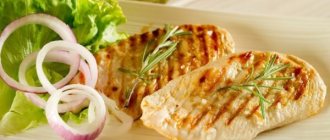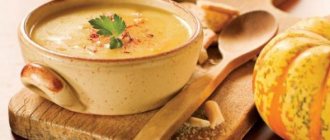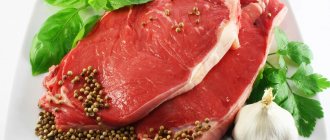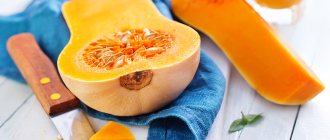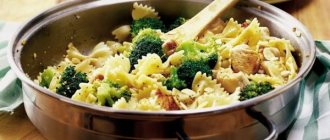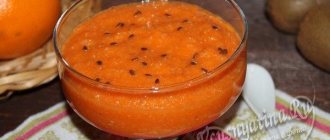Composition of puree soups
Almost any ingredients can be added to so-called cream soups, and this directly affects their composition and BJU. The first dish can be more calorie or dietary, so everyone chooses the appropriate cooking recipe.
The dish consists mainly of vegetables: cabbage, carrots, potatoes, mushrooms, tomatoes, onions and garlic. A little vegetable oil (preferably olive) is also added so that the puree soup does not turn out lean and tasteless.
The broth itself can be cooked with vegetables or meat. If you take chicken breast or beef, you will get a less nutritious dish, and pork broth will increase the calorie content of the puree soup to 150-200 kcal.
The composition may also include such non-standard ingredients as cod liver. It will increase the fat content of even the leanest vegetable soup more than butter or heavy cream, which is often used.
Broccoli soup
Products (for 4 servings)
- Potatoes (cut into cubes) - 2 pcs. (200 g)
- Onion (finely chopped) - 1 pc. (100 g)
- Broccoli - 200 g
- Carrots (cut into small pieces) - 1 pc. (100 g)
- Garlic - 1 clove (5 g)
- Water - 3 glasses (600-700 ml)
- Olive oil - 2 tbsp. spoons (30 g)
- Salt - 1 teaspoon (10 g or to taste)
Recipe
- 1. Fry the onion in a saucepan in olive oil until light golden brown.
- 2. Add the remaining ingredients and add water.
- 3. Cook broccoli soup for at least 30 minutes, covered. Turn off the heat and cool the soup.
- 4. Pour everything into a blender and grind until smooth.
- 5. Pour the broccoli soup back into the pan and heat to desired temperature.
Calorie content of puree soups
Calories and nutritional value of pureed soups per 100 g of dish depend on the ingredients used for preparation. Let's consider the energy value of dishes prepared according to several of the most popular recipes:
- pumpkin soup puree contains 93 kcal per 100 grams;
- broccoli puree soup – 85 kcal;
- cauliflower dish – 33 kcal (the most dietary among all);
- The calorie content of mashed potato soup is higher - about 45 kcal;
- mushroom soup from champignons – 85 kcal per 100 g;
- tomato puree soup – 40 kcal;
- from carrots – 70 kcal;
- from lentils, peas or beans – 50-55 kcal;
- celery puree soup – 45 kcal;
- soup made from many different vegetables - 50-60 kcal;
- with the addition of chicken or turkey – 90 kcal;
- with chicken liver – 85 kcal;
- with rice cereal – 55 kcal per 100 grams.
As you can see, the calorie content of the finished dish varies. It all depends on what exactly you add to the pan.
Content of BJU in puree soups per 100 g
The ratio of proteins, fats and carbohydrates in puree soups also depends on the ingredients. The table will help you figure it out:
| For 100 g of soup | Squirrels | Fats | Carbohydrates |
| pumpkin puree soup | 3.5 | 4.5 | 10 |
| from broccoli | 2 | 4 | 14 |
| with tomatoes | 2 | 3 | 1.5 |
| from carrots | 4 | 2 | 9 |
| with champignons | 8 | 2 | 3 |
| potato | 2 | 3 | 16 |
| with poultry | 6 | 7 | 4 |
| with rice | 1.5 | 1.5 | 8 |
| pea | 1 | 3 | 8 |
As you can see, even puree soup with meat and cream, just with meat or made from potatoes does not contain so much fat that you should refuse this dish when losing weight.
In general, cream is usually added solely for taste. By removing them from the recipe, you will reduce the calorie content and reduce the fat content of the dish.
Cooking principles
All vegetable puree soups and dishes with meat or the addition of cereals are prepared according to the same principle: using a blender and almost any ingredients. If the minimum calorie content of mushroom soup per 100 g is important, use champignons, and if the number of calories does not matter, take porcini, saffron milk caps or any other edible mushrooms.
If the recipe includes potatoes, choose a soft-cooked variety, and to add richness to the dish, add cereal (rice can be used). Cut all ingredients into cubes so they cook evenly.
Vegetables need to be filled with water, brought to a boil and cooked for several minutes, depending on the ingredients. Tomatoes, cauliflower and broccoli cook faster, while peas, chicken and carrots take longer.
When preparing vegetable soup, fry the onion in a frying pan until golden brown - this will add a unique aroma. Cauliflower and broccoli should be separated into inflorescences before cooking, and carrots can be grated on a coarse grater.
Just cut the potatoes and zucchini into cubes. Garlic, parsley, and dill are added last. Salt and pepper to taste. When grinding with a blender, add cream or vegetable oil to add tenderness to the taste.
As you can see, there is nothing complicated in making puree soups. Use whatever ingredients you have in the fridge and you'll be good to go. The low calorie content of this dish will not affect your figure!
How many calories are in soup: table of KBJU first courses
Soup is considered a low-calorie dish, but adding cream, butter, cheese and other high-fat ingredients increases the calorie count.
Borscht cooked in water contains less than 40 kcal/100 ml, while Ukrainian borscht with meat prepared according to the classic recipe contains more than 60 kcal/100 ml. Soups made from lentils, peas and beans cannot be called low-calorie, but they contain vegetable protein, which provides a person with a feeling of fullness for a long time. WEIGHT LOSS STORIES OF STARS!
Irina Pegova shocked everyone with her weight loss recipe: “I lost 27 kg and continue to lose weight, I just brew it at night. » Read more >>
Diet soup or borscht is prepared with water, without adding butter, sour cream or meat. One plate of this dish contains a minimum amount of calories (about 100 kcal per serving).
A bowl of chicken soup with potatoes contains about 150 kcal, and rice soup cooked in meat broth with the addition of sour cream contains more than 200 kcal.
The calorie content of first courses and their nutritional value (BJU) are presented in the table.
| Soup variety | BJU (content per 100 grams of product) | Number of calories (kcal) in 100 grams of soup (100 ml) | Calorie content per serving (300 grams) |
| Pea | 3,6/0,9/11,15 | 68,5 | 205,5 |
| Bean | 3,95/1,95/10,15 | 65,5 | 196,5 |
| Borscht cooked in chicken broth | 4,55/1,6/4,4 | 48 | 144 |
| Lenten borscht | 0,7/2,4/2,15 | 37 | 111 |
| Borscht cooked in meat broth with beef | 4,15/1,8/2,2 | 59 | 177 |
| Borscht with pork | 2,1/2,4/6,5 | 70 | 210 |
| Minestrone (vegetable soup) | 1,5/1,7/6,1 | 39 | 117 |
| Kharcho | 3/4,55/5,9 | 67 | 201 |
| Chicken meatball soup | 4,4/3/2,7 | 45,5 | 136,5 |
| Chicken with noodles | 4,8/3,4/6,7 | 55 | 165 |
| Oat | 1,4/1,6/5,55 | 39,5 | 118,5 |
| Potato with pasta | 1,6/0,95/8,9 | 54 | 162 |
| White cabbage soup | 0,3/1,55/1,9 | 26 | 78 |
| Mushroom with buckwheat | 0,7/3,15/4,35 | 49,5 | 148,5 |
To reduce the energy value of the first dish, you need to adhere to the following rules:
- 1. Do not fry vegetables. You should avoid frying or do it with a minimum amount of vegetable oil. Refined sunflower oil contains more than 900 kcal, and unrefined olive oil contains about 850 kcal. Amaranth contains about 700 kcal.
- 2. Use meat without skin. It is necessary to remove it from poultry meat before cooking chicken or turkey broth, and clean pork and beef from films, veins and cut off fat.
- 3. Avoid fatty sauces. High-calorie mayonnaise should be replaced with low-fat sour cream. When preparing cream soup, you should not use heavy homemade cream, but 10% pasteurized cream. Milk with minimal fat content should be added to milk soup.
- 4. Drain the first broth. It is necessary to cook the soup not in the first, but in the second or third broth. To do this, after boiling, drain the water and get clean water, and when it boils, you can add cereals and vegetables.
If cheese is specified in the recipe for the first course, then low-fat varieties should be used. There is no need to add processed cheese (their calorie content is about 300 kcal/100 g).
How many calories are in pureed vegetable soup?
We will need:
Onions - 1 piece (110g); Carrots - 2 pcs (180g); Celery stalk - 3 pcs (90g); Small potatoes - 5 pcs (500g); Chicken broth (or water) - 1.5 liters; Wheat flour - 3 tablespoons (50g); Low fat milk - 1 glass (200g); Cream of minimal fat content (optional) - 1/2 cup (150g); Salt and pepper - to taste; Vegetable oil - 2 tablespoons (20g); Parsley - a couple of sprigs; Khmeli-suneli seasoning - to taste; Cheese - to taste (optional).
First of all, cook the broth. I cooked from chicken fillet (added chicken fillet to the water, brought to a boil, removed the noise and cooked for 30 minutes). During this time we prepare the vegetables. Peel the onions and carrots and chop them finely. If the celery is large, then cut it into several strips and then cut into small cubes. Place all the vegetables in a pan with oil and simmer over medium heat. During this time, while the vegetables are stewing, peel and cut the potatoes into small cubes. Add to the vegetables, mix and simmer for another 5 minutes. Now, salt well (potatoes require this) and pepper. Mix. Then add broth (or water). Bring to a boil and cook for about 10 minutes (or until the potatoes are cooked). During this time, whisk the milk and flour until smooth. Add to the soup and cook for another five minutes, making sure that all the vegetables are already cooked. Then, put half of the soup with vegetables into a blender. Beat well, starting at low speed, until smooth. Add the puree to the soup and mix well. Add cream. Mix well and cook over low heat until the first bubbles appear. The soup is ready! During cooking, taste, add seasoning, salt and pepper if necessary. Finely chop the parsley. Three cheeses (what kind of cheese you use doesn't matter at all in this soup. Any kind will do!). Add chopped parsley to the finished soup and stir. Pour into plates, add cheese and enjoy
How to prepare the dish “Vegetable puree soup”
- Cut the Brussels sprouts into 4 pieces and separate the cauliflower into florets.
- Grate the carrots on a coarse grater, cut the zucchini and potatoes into cubes.
- Place carrots in boiling water and cook for 15 minutes.
- Then add potatoes.
- After another 10 minutes, add salt, zucchini, cut heads of Brussels sprouts, cauliflower florets to the soup and cook for 15 minutes.
- 5 minutes before turning off, add finely chopped garlic and parsley to the soup.
- Zucchini - 235 gr.
- Carrots - 32 gr.
- Cauliflower - 175 gr.
- Brussels sprouts - 100 gr.
- Potatoes - 155 gr.
- Garlic - 3 teeth.
- Parsley - 10 gr.
- Salt - 6 gr.
- Water - 908 gr.
Nutritional value of the dish “Vegetable puree soup” (per 100 grams):
Puree soups have a fairly high nutritional value, so they are superior in calorie content to traditional light soups. Thick, creamy dishes contain more proteins, fats and carbohydrates, although they are prepared from similar products.
TOP 5 TASTY AND NO-CALORIE SOUP-PUREE
Puree soup with mushrooms Per 100 grams - 64.43 kcal USED - 3.19/3.13/6.66
Ingredients: Champignons 800 g Potatoes 4 pieces Onion 1 piece Carrots 1 piece Cream 20% 3 tablespoons Olive oil 3 tbsp Salt, ground black pepper to taste Black peppercorns to taste Bay leaf to taste
Preparation: 1. Boil potatoes with mushrooms (do not cut mushrooms!) in a small amount of water. When cooking, add bay leaf, salt and peppercorns. 2. To prepare the dressing, heat olive oil in a saucepan, add finely chopped onions and carrots, fry until barely golden brown and turn off. Beat everything with a blender into a homogeneous mass, pour in the cream and the remaining olive oil from the saucepan. 3. Blend potatoes and mushrooms with a blender until smooth, stir in dressing and 1 cup of potato and mushroom broth. Mix well again. Add ground pepper to taste. 4. Serve with sour cream and crackers, garnished with green onions.
Cauliflower soup with nutmeg Per 100 grams - 52.68 kcal USED - 3.4/2.25/5.18
Ingredients: Cauliflower 1 piece Wheat flour 1.5 tablespoons Onion 1 head Chicken broth 2.5 cups Chicken egg 2 pieces Cream ⅔ cup Cheese to taste Nutmeg to taste Salt, ground black pepper to taste
Preparation: 1. Divide the cabbage into inflorescences and cook in salted water for 5 minutes. 2. Heat the oil, add flour to the frying pan and hold on low heat for 2 minutes. 3. Add heated flour and finely chopped onions to the chicken broth. Bring to a boil, then simmer over low heat for 20 minutes. 4. Add cauliflower to the cooled broth. Stir the soup thoroughly, strain through a sieve and bring to a boil. 5. Whip cream with egg yolks, add a little hard grated cheese. Dilute the mixture with a cup of broth, then pour it into the soup pot. Heat, but do not bring to a boil. 6. 5 minutes before readiness, add salt, pepper and a few shavings of nutmeg.
Onion soup puree Per 100 grams - 149.94 kcal USED - 2.46/11.07/10.81
Ingredients: Potatoes 600 g Onions 200 g Cream 200 ml Carrots 100 g Turnips 100 g Cheese 40 g Dill 1 tablespoon Parsley 1 tablespoon Salt to taste
Preparation: 1 Chop the onion and fry in oil. Chop carrots and turnips, fry and boil along with chopped potatoes. Wipe. 2 Mix everything with fried onions, add cream or milk, grated cheese and cook the soup until done. 3 Before serving, sprinkle with chopped dill and parsley.
Broccoli soup with croutons Per 100 grams - 49.11 kcal USED - 2.43/1.88/6.67
Ingredients: Broccoli - 600 g Large chopped onion - 1 pc. Peeled garlic - 2-4 cloves Vegetable broth - 4 cups Large boiled potato, chopped - 1 pc. Raw cashew nuts - 1/4-1/2 cup Salt, black, red pepper - to taste White bread - for croutons
Preparation: 1. Place broccoli, onion, garlic and vegetable broth in a saucepan. Bring the broth to a boil, cover and reduce heat. Simmer until broccoli is tender, about 8 minutes. 2. Place half the broccoli and broth in a blender with half the potatoes and cashews. Beat until smooth. Transfer to another pan and repeat with remaining broccoli, potatoes and cashews. 3. Cover the soup with a lid and heat over low heat for 10 minutes. Add salt, freshly ground black pepper and a pinch of red pepper to taste. 4. Cut the bread into cubes, cutting off the crusts. Fry in a dry frying pan or dry in the oven. 5. Serve the finished soup with croutons.
Cream vegetable soup Per 100 grams - 54.77 kcal USED - 2.51/1.99/6.78
Ingredients: Onions - 1 pc. Carrots - 2 pcs. Celery stalk - 3 stalks. Potatoes - 5 pcs. Chicken broth (or water) - 1.5 liters; Wheat flour - 3 tbsp. spoons Low fat milk - 1 cup Low fat cream (optional) - 1/2 cup Olive oil - 2 tbsp. spoons Parsley - a couple of sprigs; Khmeli-suneli seasoning - to taste; Salt and pepper - to taste; Cheese - to taste (optional);
Preparation: First of all, cook the broth. I cooked from chicken fillet (added chicken fillet to the water, brought to a boil, removed the noise and cooked for 30 minutes). During this time we prepare the vegetables. Peel the onions and carrots and chop them finely. If the celery is large, then cut it into several strips and then cut into small cubes. Place all the vegetables in a pan with oil and simmer over medium heat. During this time, while the vegetables are stewing, peel and cut the potatoes into small cubes. Add to the vegetables, mix and simmer for another 5 minutes. Now, salt well (potatoes require this) and pepper. Mix. Then add broth (or water). Bring to a boil and cook for about 10 minutes (or until the potatoes are cooked). During this time, whisk the milk and flour until smooth. Add to the soup and cook for another five minutes, making sure that all the vegetables are already cooked. Then, put half of the soup with vegetables into a blender. Beat well, starting at low speed, until smooth. Add the puree to the soup and mix well. Add cream. Mix well and cook over low heat until the first bubbles appear. The soup is ready! During cooking, taste, add seasoning, salt and pepper if necessary. Finely chop the parsley. Three cheeses (what kind of cheese you use doesn't matter at all in this soup. Any kind will do!). Add chopped parsley to the finished soup and stir. Pour into bowls, add cheese and enjoy!
Bon appetit!
Composition of puree soups
Almost any ingredients can be added to so-called cream soups, and this directly affects their composition and BJU. The first dish can be more calorie or dietary, so everyone chooses the appropriate cooking recipe.
The dish consists mainly of vegetables: cabbage, carrots, potatoes, mushrooms, tomatoes, onions and garlic. A little vegetable oil (preferably olive) is also added so that the puree soup does not turn out lean and tasteless.
The broth itself can be cooked with vegetables or meat. If you take chicken breast or beef, you will get a less nutritious dish, and pork broth will increase the calorie content of the puree soup to 150-200 kcal.
The composition may also include such non-standard ingredients as cod liver. It will increase the fat content of even the leanest vegetable soup more than butter or heavy cream, which is often used.
Potato soup
Products (for 4 servings)
- Water - 1.5 l
- Potatoes - 0.5 kg
- Carrots – 300 g
- Onion - 2 pcs.
- Butter - 40 g
- Parsley - 1 bunch
- Ground black pepper - on the tip of a knife (to taste)
- Salt - 1 teaspoon (to taste)
Recipe
- Peel the potatoes, wash them, cut them into strips.
- Pour cold water over the potatoes and bring to a boil.
- Cook the potatoes for 15-20 minutes over low heat, covered.
- Peel the onion, wash it, chop it.
- Peel the carrots, wash them, chop them on a coarse grater.
- Wash the greens and chop finely.
- Melt butter in a frying pan. Place onions and carrots in hot oil. Fry the vegetables in melted butter over medium heat, stirring, until soft (2-3 minutes). Add salt.
- Season the soup with salt and pepper, add fried carrots and onions.
- Cook over low heat, covered, for another 7-10 minutes.
- Rub the soup through a sieve or puree in a blender.
- The mashed potato soup is ready.
- Serve mashed potato soup with butter, sprinkled with chopped herbs.
- Bon appetit!
Calorie content of puree soups
Calories and nutritional value of pureed soups per 100 g of dish depend on the ingredients used for preparation. Let's consider the energy value of dishes prepared according to several of the most popular recipes:
- pumpkin soup puree contains 93 kcal per 100 grams;
- broccoli puree soup – 85 kcal;
- cauliflower dish – 33 kcal (the most dietary among all);
- The calorie content of mashed potato soup is higher - about 45 kcal;
- mushroom soup from champignons – 85 kcal per 100 g;
- tomato puree soup – 40 kcal;
- from carrots – 70 kcal;
- from lentils, peas or beans – 50-55 kcal;
- celery puree soup – 45 kcal;
- soup made from many different vegetables - 50-60 kcal;
- with the addition of chicken or turkey – 90 kcal;
- with chicken liver – 85 kcal;
- with rice cereal – 55 kcal per 100 grams.
As you can see, the calorie content of the finished dish varies. It all depends on what exactly you add to the pan.
Content of BJU in puree soups per 100 g
The ratio of proteins, fats and carbohydrates in puree soups also depends on the ingredients. The table will help you figure it out:
| For 100 g of soup | Squirrels | Fats | Carbohydrates |
| pumpkin puree soup | 3.5 | 4.5 | 10 |
| from broccoli | 2 | 4 | 14 |
| with tomatoes | 2 | 3 | 1.5 |
| from carrots | 4 | 2 | 9 |
| with champignons | 8 | 2 | 3 |
| potato | 2 | 3 | 16 |
| with poultry | 6 | 7 | 4 |
| with rice | 1.5 | 1.5 | 8 |
| pea | 1 | 3 | 8 |
As you can see, even puree soup with meat and cream, just with meat or made from potatoes does not contain so much fat that you should refuse this dish when losing weight.
In general, cream is usually added solely for taste. By removing them from the recipe, you will reduce the calorie content and reduce the fat content of the dish.
Cooking principles
All vegetable puree soups and dishes with meat or the addition of cereals are prepared according to the same principle: using a blender and almost any ingredients. If the minimum calorie content of mushroom soup per 100 g is important, use champignons, and if the number of calories does not matter, take porcini, saffron milk caps or any other edible mushrooms.
If the recipe includes potatoes, choose a soft-cooked variety, and to add richness to the dish, add cereal (rice can be used). Cut all ingredients into cubes so they cook evenly.
Vegetables need to be filled with water, brought to a boil and cooked for several minutes, depending on the ingredients. Tomatoes, cauliflower and broccoli cook faster, while peas, chicken and carrots take longer.
When preparing vegetable soup, fry the onion in a frying pan until golden brown - this will add a unique aroma. Cauliflower and broccoli should be separated into inflorescences before cooking, and carrots can be grated on a coarse grater.
Just cut the potatoes and zucchini into cubes. Garlic, parsley, and dill are added last. Salt and pepper to taste. When grinding with a blender, add cream or vegetable oil to add tenderness to the taste.
As you can see, there is nothing complicated in making puree soups. Use whatever ingredients you have in the fridge and you'll be good to go. The low calorie content of this dish will not affect your figure!
Related Products
Chili soup (57 cal) Carrot coriander soup (100 cal) Lentil soup (54 cal) Clear soup (8 cal) Chicken soup (60 cal) Potato soup (63 cal) Mushroom soup (51 cal) ) Tomato soup (43 cal) Bean soup (74 cal) Fish soup (16 cal) Turtle soup (53 cal) Onion soup (44 cal) Noodle soup (35 cal) Beef soup (50 cal) Pea Soup (67 cal) Vegetable Pasta Soup (44 cal) Broccoli Soup (60 cal) Homemade Soups (22 cal) Turkey Soup (38 cal) Cream Soups (52 kcal.) Meat soup (50 kcal.) Oyster stew soup (40 kcal.) Chinese soup (33 kcal.) Shark fin soup (46 kcal.) Cheese soup (76 kcal.)
Calorie table for soups and their nutritional value
The nutritional value of the main types of first courses is presented in the table:
| Soup name | Calorie content (kcal per 100 ml) |
| Chicken | 36 |
| Pea | 66 |
| Mushroom | 26 |
| Kharcho | 67 |
| With meatballs | 45,5 |
| Buckwheat | 33,6 |
| With vermicelli | 48 |
| Vegetable puree soup with chicken broth | 58,2 |
| Vegetable puree soup with meat broth | 21,1 |
| Sauerkraut cabbage soup | 32 |
| Cabbage soup with sour cream (depending on the fat content of sour cream) | 37,1-51,44 |
| Rassolnik | 42 |
| Solyanka (with beef and tomato) | 100 |
| Borsch | 49 |
| Minestrone (vegetable soup) | 39 |
| Beans with pepper | 63 |
| Onion with carrots | 44 |
| Potato | 38 |
Cabbage soup puree
Products
- White cabbage – 250 g
- Potatoes - 2 pcs. (150 g)
- Carrots - 1 pc. (50 g)
- Onion - 1 pc. (50 g)
- Olive oil - 2 tbsp. spoons
- Garlic - 1 clove
- Fresh dill (for serving) - to taste
- Salt - to taste
- Ground black pepper - to taste
- Crackers (for serving, optional) - to taste
- Water – 700 ml
Recipe
- Peel the onion, carrots and garlic and cut into arbitrary pieces.
- Heat the olive oil in a heavy-bottomed saucepan and fry the onions and carrots for 2-3 minutes. Add garlic, stir.
- Fill the contents of the pan with hot water and bring to a boil.
- Peel the potatoes and cut into large pieces.
- Add potatoes to boiling water. Add salt to taste.
- Cut the cabbage into large pieces.
- Add the cabbage to the pan and cook for 20-25 minutes at a low simmer. Add ground black pepper to taste.
- Puree the finished soup using an immersion blender.
- Finely chop the dill.
- Pour the puree soup into serving bowls and sprinkle with chopped herbs. If desired, you can add croutons to the soup.
- Bon appetit!
Secrets on how to reduce the calorie content of soup
Body weight directly depends on the nutritional value of the soups consumed.
Nutritionists have calculated that a daily decrease in the energy value of a dish by just 100 kcal prevents the appearance of 1 kg of excess weight per year.
There are several simple rules, following which you can get rid of 500 grams of fat every week.
Cook with low-calorie foods
Many dishes will not lose their taste (or gain it) if their ingredients are changed.
For example, you can safely change components:
- whole milk – low-calorie;
- butter - olive oil or any vegetable oil;
- fatty meat (sausage, ham) - fish or lean veal;
- cereals - for vegetables and herbs;
- mayonnaise - for natural yogurt;
- sugar – for fructose, etc.
Important! It is advisable not to use starch, potatoes, rice, flour, sugar, seasonings with a high salt content, or canned foods when preparing dishes.
Do not fry vegetables
Fried food adds at least 150 kcal to each soup. An alternative is raw or steamed vegetables.
Use skinless meat
The main source of carbohydrates and fats is found not in the chicken flesh itself, but in its skin. When cooking meat, the skin must be removed.
Avoid fatty sauces
A good alternative to mayonnaise, full-fat sour cream and ketchup would be mustard, lemon or homemade pesto sauce with garlic and basil, natural yogurt, balsamic vinegar, etc.
Drain the first broth
When cooking broth, the first portion must be drained - it is full of antibiotics and chemicals that the animal consumed along with the food. The second broth is healthier and cleaner.
Do not use sour cream
Sour cream is a fairly fatty product. It is best to replace it with natural yogurt, mustard or homemade tomato paste.
